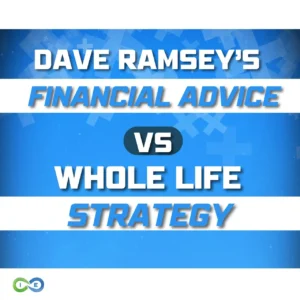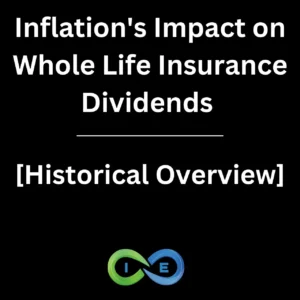Retirement planning with whole life insurance is a powerful “holistic” strategy that should, at a minimum, be included as a integral part of a plan that includes other “traditional” components of a life insurance retirement plan( LIRP).
“Holistic” emphasizes the importance of the whole and the interdependence of its parts…
In other words, focusing only on one part of planning, such as a potential return on investment, at the expense of other parts, such as safety or your peace of mind, does not make for a good retirement planning strategy.
This is why retirement planning with whole life insurance, or more specifically, designing a retirement plan that includes a type of cash value life insurance known as dividend paying whole life insurance for a unique purpose is an important part of any complete retirement plan.
This whole life insurance retirement planning strategy will be revealed in this article to follow.
Using Whole Life Insurance for Retirement Planning
Some of the various characteristics of retirement planning with whole life insurance and unpacking what is perhaps the best investment for an effective retirement planning strategy are:
- Safety
- Growth
- Predictability
- Flexibility
- Peace of mind
Yet, regardless of these 5 parts, a majority of the financial community continues to recommend strategies that offer few if any of the above.
Let’s review what most financial advisors recommend to average folks planning for retirement:
- Buy cheap term life insurance with a sufficient death benefit to provide for family’s needs.
- Max out “work sponsored plans” such as 401(k) accounts or contribute to an IRA or Roth IRA.
How do Conventional Retirement Accounts such as 401(k) and IRA Accounts Fare Based on our 5 Part Holistic Retirement Plan Test?
#1 Safety
History has proven that the stock market is given to boom and bust cycles. In 2007, many folks experienced massive reductions in their retirement savings due to the bust cycle.
So, simply put, component #1 above is not satisfied by any market based investment strategy. Even a so called “conservative” fund that is invested in the financial markets still carries an unacceptable amount of risk.
And with the S&P hovering around an unprecedented new market high, another substantial market correction may not be far off. This is why Robert Kiyosaki suggests that everyone have a “safe bucket” and this is especially critical for retirement planning.
#2 Growth
Again, given the cyclical nature of the stock market, the ability to predict growth with any degree of certainty is impossible. Remember, a financial account that suffers a loss takes longer to recover based upon the principles of basic math. You may have been shown the illustration that depicts how an investment that loses 10% in a given time period will take longer to get back to even because of the loss of account principal leading to a smaller return.
Of course, another factor that hinders growth is the fees and costs for administering the account. When analyzing mutual funds, it is often very difficult to identify the fees even with tougher standards being enacted against fund managers. Depending upon the account, these fees can be substantial and can seriously hinder growth prospects, even in a growing market environment.
#3 Predictability
Often, financial pundits like Dave Ramsey tout numbers such as 12% returns, and yet it is clear that these numbers are often NOT the reality in today’s stock market.
We live in world where a suggestion of rising interest rates can cause the market to decline significantly on any given day. For the average person who is not a “Warren Buffet”, there is little predictability in the stock market.
Referring back to the circumstances of 2007, few anticipated the dramatic impact that various factors (such as the secret derivatives market which is bigger today than in 2007) had upon the markets. And of course this black swan event can always happen again.
#4 Flexibility
I won’t even address traditional IRAs and 401(k) accounts due to the total inflexibility of these accounts as a highly regulated tax deferred IRS savings account. In a previous post, we did discuss the restrictions that apply to Roth IRA, which is the most flexible conventional retirement account option available.
By flexibility, I mean that the cash value in the fund is available for use during retirement with minimal fees and restrictions. However, as we pointed out in our article covering cash value life insurance benefits, there are many restrictions that still apply to the Roth IRA. Simply put, the Roth IRA is still a highly regulated asset and thereby lacks flexibility.
#5 Peace of Mind
Admittedly, this component is a bit more introspective because it can mean different things to different people. Some folks have a higher tolerance for risk; however, it can be argued that the retirement planning component of one’s investment portfolio should be a safe place for savings and not subject to risk.
Ask yourself whether a reasonable person should roll the dice in the markets with their entire retirement plan, and thereby consciously choose to forego the peace of mind that can be found through the first 4 components above. Does this sound reasonable to you? Do you think there is no other option when building your retirement plan?
How Does Whole Life Insurance Fare Based Upon Our 5 Part Holistic Retirement Plan Test?
#1 Safety
As discussed in our post discussing the history of whole life insurance, whole life has stood the test of time and offered consistent returns and even continuing life insurance dividends through the most difficult economic environments, such as the Great Depression. Simply put, this financial asset is a bulwark against all manner of crisis that can impact the financial markets.
#2 Growth
Cash value life insurance coverage usually guarantees a rate of return around 4% with today’s interest rates and this return should be viewed as a baseline because the non-guaranteed portion of the policy includes dividends that are tax free and reinvested.
Along with dividends, policy loans that are repaid will also add to the cash value of the policy and results in a higher rate of return on investment in the policy, and this is all part of the infinite banking concept or self banking strategy discussed in prior posts.
When using whole life insurance for retirement, you have a ready source of retirement income that can be accessed income tax free via policy loans. And with the guaranteed growth and potential dividends, your policy’s death benefit and cash value may continue to grow, even after using part of it for income in retirement.
#3 Predictability
Cash value life insurance is a contract between the policy holder and the life insurance company and part of this contract is a guaranteed “contractual” rate of return backed by the financial strength of the insurance company.
So, whole life is a thoroughly predictable retirement plan compared with market based retirement account assets, and as stated in #2 above, this forecast is very conservative when considering likely dividends and additional interest and cash accrual that will occur when the whole life policy with paid-up additions rider is utilized as a strategic self banking strategy.
And you can choose limited pay life insurance to increase your policy’s predictability. Limited pay life insurance policies are paid up over a period of time, so you get the benefits inherent in whole life insurance policies but without having to continue to make premium payments.
#4 Flexibility
Cash value life insurance offers the incentive of tax free growth of the Roth IRA AND greatly increases flexibility in that the policy proceeds may be borrowed without penalty or tax consequences and none of the other restrictions of Roth IRAs are applicable. This means that you have total control over this asset and if you choose to treat your whole life policy like a business, the repaid loan interest maximizes the policy return for both the cash value and the death benefit.
#5 Peace of Mind
Whole life offers peace of mind because of the guaranteed growth. But because it is life insurance, it also provides an accelerated death benefit that allows you to access your death benefit if you are diagnosed terminally ill, with some whole life insurance policies also covering chronic illness and long-term care.
So, how would it feel to have a retirement plan that offers complete safety, guaranteed growth, total predictability, flexibility and peace of mind?
To answer this question, you need to really understand the power of cash value whole life insurance as a retirement planning strategy.
Does this all sound too good to be true?
Perhaps it does; however, there is a reason why America’s largest corporations and banks own huge portfolios of participating cash value life insurance.
Of Course, the Community of Stockbrokers and Other Advisors Is Poised With Ready Objections to this Holistic Retirement Planning Strategy such as:
- whole life insurance coverage locks up your investment funds into an expensive investment with huge up front fees
- whole life insurance policies charges huge surrender charges if you stop paying the premium payments
- there are tax consequences if you withdraw your earnings upon surrendering the policy
- unpaid life insurance premiums can “eat up the cash value”
- whole life insurance plans results in people being under insured because the death benefit is expensive
- whole life insurance plans are only appropriate for the wealthy who’ve fully funded all tax advantaged retirement accounts or as “legacy enhancement” for diverting required minimum distributions from IRAs and 401(k) accounts toward premiums.
In her book, Bank on Yourself, Pamela Yellen responds to these objections in noting,
“…stockbrokers and others tied to Wall Street” have given a “bum rap” to whole life policies for “hefty up front fees”, and that “they don’t even tell you how much the advisor is making.” It is true that the insurance companies do not provide a detail of this fee. However, Barbara proposes the example of buying a vacuum cleaner at Sears…”do you really want to know the commission that the sales guy made, how much it cost to deliver it to the store or how much it cost the factory to build it?”
Really, you just want to know how much the product cost out of pocket and what you end up with…the policy illustration will show this in detail with all costs and commissions deducted. In contrast, she says that numerous studies show that fees in traditional retirement plans can consume as much as 1/3 to 1/2 of your account over time.”
As for surrender charges and tax consequences, these objections should be considered “a wash” because, as we all well know, traditional retirement accounts also carry penalties and tax consequences for “earned income”. However, with cash value life insurance, the penalties only apply if the policy is surrendered or if income is withdrawn from the policy over the amount of paid premiums, i.e. the basis.
Typically, it is advisable for those practicing self banking strategies to utilize policy loans rather than outright withdrawals due to the tax issues involved; however, even if a cash withdrawal is used, the result is on par with traditional retirement accounts.
Of course, unpaid life insurance premiums can eat up the cash value; however, this objection is nonsense because this is a function of how the policies work and actually acts as a benefit. What this really means is that if the base premium of the policy is not paid, and there is cash value in the policy, then the cash can be used to pay the base premium in order to keep the policy in force.
Understand that as long as it is economically feasible for the policy holder to pay the base premium, it is highly advisable to continue to do so in order to foster ongoing growth in the cash value. This is really more of a clarification than an objection, given the fact that paying the premium buys you a product…a guaranteed return on investment, death benefit, dividends, etc.
Remember, conventional retirement accounts are not a financial product in the pure sense that one purchases a product…they are simply an IRS regulated account to hold your deposits which are then invested in a particular fund of choice. These are not based on a true contract and there are no projected guarantees but rather only speculation. Even the fees for “administering” the accounts are cryptic.
At least, when purchasing whole life insurance, you know that you’re buying something of ultimate value that will pay dividends and will offer tax free growth, total control and total flexibility.
Often, this objection is used due to the high cost of the death benefit. This is another objection that I would define as “nonsense” in that it defies common sense. Of course a permanent life insurance policy is more expensive than term life insurance…it offers permanent protection vs protection for a season. Think owning a home (and the equity) rather than renting.
Do You Want Coverage for Life?
Stockbrokers and other financial advisors usually attack whole life by saying something like “if someone desires life insurance protection for life…” But who would not want life insurance protection for life?
A couple of weeks ago, I posed the question whether it is more prudent to spend more for life insurance when you’re younger…during prime earning years…or when older and nearing retirement, when the coverage cost a ton more.
The answer is simple, everyone would prefer to have coverage for their entire life and buy it when it the cost is lowest. The problem is when the value of whole life insurance as a true “life” product and not simply a “death” product is glossed over or missed entirely due to misinformation or ignorance.
Buy Term Insurance and Invest the Difference
Another common bit of “advice” from entertainers like Dave Ramsey and Suze Orman is to buy term and invest the difference and then “self insure”.
Again, this entire premise relies upon a huge roll of the dice that somehow the stock market will stay consistent, when it hasn’t in the past, and will offer extremely high returns, sufficient to exceed the guaranteed policy growth offered by a solid whole life insurance policy utilized with an infinite banking strategy.
This is why in we have a clear favorite when it comes to the whole life vs term life insurance debate. We’ll leave you in suspense on what our verdict is.
In any event, a term rider can be utilized to add additional death benefit during the time that the whole life policy death benefit is accruing and this term rider can drop off at a later date. So, this objection is kind of a non-objection but rather a clarification.
The Lie that Whole Life is Only for the Wealthy
While it is true thatthe wealthiest individuals understand the power of whole life insurance as an investment, this strategy is NOT only for the wealthy.
A common misconception is that life insurance is only appropriate for wealthy households who’ve fully funded tax advantaged accounts or to allocate required minimum distributions to policy premiums.
In fact, a whole life insurance policy is considered an asset and this is a fact regardless of net worth. People build wealth by buying assets rather than liabilities.
Moreover, whole life insurance is unique because it is a valuable conduit for safeguarding all your other assets.
I revert to my question that
if the wealthiest individuals and companies are doing something, then shouldn’t a less wealthy person consider it also?
The objection to this question presumes that the wealthiest individuals are relying upon 401(k) accounts and IRAs as a retirement strategy, and in my experience, this is definitely not the case.
In fact, maxing out one’s “tax advantaged” account could be deemed an extremely poor retirement strategy for a wealthy person if you believe that taxes are likely to increase and that you dollar is worth more now than in the future.
Both answers are easy when you gain a basic understanding of money and do a cursory history lesson on taxes.
Next Steps
The next step of course is to get a closer look at how the permanent life insurance and specifically whole life and the infinite banking strategy can be utilized for your retirement planning.
After all, it meets the 5 components of a holistic retirement plan like no other strategy can AND it offers guaranteed tax free growth, dividends, permanent protection AND peace of mind.
And you haven’t even heard the best part about how it can be utilized to recapture all of the debt costs that you’re paying to third party lenders and put your retirement plan on steroids, its time to take action and schedule your complimentary strategy session today!






2 comments
Marilou Singson
I’d like to know more about LIRP. I’m 61 yrs old and so is it still advisable for me to have an LIRP account?
Insurance&Estates
Hi Marilou,
Choosing a LIRP at 61 years old might be a great idea. However, it really depends on your specific circumstances. We have forwarded your info to our LIRP practitioner, Barry Brooksby. If you have not heard from him, you can reach Barry Brooksby at barry@insuranceandestates.com.
Sincerely,
I&E